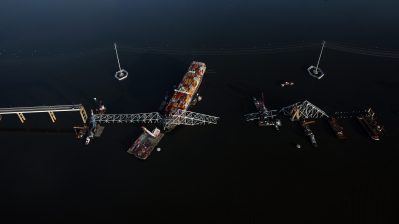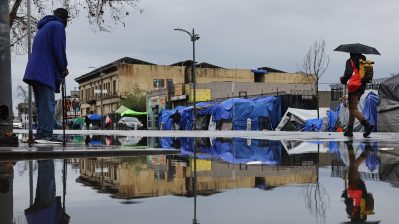When it pours in dry LA, water quickly runs out to sea
Winter rains finally hit water-starved southern California in January. The first bands of El Niño storms delivered around three inches to Los Angeles alone, and more is expected. But nearly all that water went straight into the Pacific Ocean. After four years of punishing drought, that may seem like a colossal waste, but the people who built this sprawling West Coast metropolis wanted it that way.
To understand, rewind to the early 20th century, when rain was seen as a threat to the city’s rapid economic development. A series of deadly floods hit the city, killing hundreds of people, destroying homes, railroad lines, bridges and roads. Woody Guthrie sang about one of those disasters in “The New Year’s Flood.”
Kind friend do you remember,
On that fatal New Year’s night?
The lights of old Los Angeles,
Was a-flickering oh so bright.
A cloudburst hit the mountains,
It swept away our homes.
And a hundred souls was taken
In that fatal New Year’s flood.
A rail line collapses in the flooded Los Angeles River in 1938.
That was 1934. In 1938, another flood devastated the region. Fatality reports vary, but in Los Angeles County alone, at least 87 people died, thousands lost their homes and a third of the city was inundated with floodwaters. Nine-one railroad and highway bridges collapsed, parts of major highways washed away, and sewage lines ruptured.
According to Blake Gumprecht in “The Los Angeles River: Its Life, Death and Possible Rebirth,” the climactic scenes of the novel “City of Angels” are based on the flood. Author Rupert Hughes wrote “it was as if the Pacific had moved in to take back its ancient bed.”
With that history of floods and destruction, rainwater was something to be controlled and sent out of the city as quickly as possible. Los Angeles was designed to keep humans and water apart.
“LA was literally built as a drain,” Tree People founder Andy Lipkis said.
As the city developed in the 1900’s, building codes made sure that rainwater quickly flowed off residential and business property into city streets, down storm drains, into channelized rivers and out to the ocean. “It flows off our property so quickly that we don’t see it, it’s gone,” Lipkis said.
Julia Bowie/Marketplace
Flood control efforts had started before the 1938 flood, but after that, the full-blown “channelization” of flood-prone waterways like the Los Angeles River began in earnest. U.S. military commanders helped persuade Congress to pay for the effort, citing the location of “national defense industries” like Lockheed Martin and Douglas Aircraft in the city.
“The Army Corps of Engineers did it,and it was a massive project,” Lewis MacAdams said. MacAdams , founder of Friends of the Los Angeles River, said the effort was hailed as a job creator when so many Americans were out of work.
Workers search for missing bodies after floodwaters destroy a home in Glendale in 1938.
“There were 17,000 people paving the river by hand at the end of the Depression,” he said. “Three million barrels of concrete were poured. The Corps of Engineers put out a little book after, they were so proud of this paving, and the word ecology was never mentioned or the idea that in a Mediterranean climate it might be valuable to hold onto that water.”
The Army Corps straightened, widened and deepened the unpredictable river so it wouldn’t overflow its banks and threaten homes and businesses. The vast network of dams, concrete channels, catch basins and over 2,000 miles of storm drain pipe fixed Los Angeles’s worst flood problems. But residents were now physically and psychologically separated from the city’s main waterway.
“The L.A. River became totally off limits,” environmental historian Robert Gottlieb said. “There was actual barbed wire in places. The sense that you keep away, this is a place of danger.”
Hollywood reinforced that scary image in films like “Terminator 2.” So did a science fiction film in the 1950’s called “Them.” Gottlieb cited the film’s “irradiated ants crawling out of the storm drains to wreak havoc on Los Angeles.”
Tony Wagner/Marketplace
Few residents ventured to see the river. In the dry months it was a mere trickle of treated sewage water and irrigation runoff, and the banks were often marred by graffiti and garbage. Even homes built near the river usually faced away from it. So the storm water that flowed through it in winter was out of sight, out of mind and relatively devalued.
That’s beginning to change.
Right now the city of Los Angeles captures just eight percent of the water that falls or flows into the city. But it’s working to improve that.
Los Angeles’ Leimert Park during the flood of 1938.
In the San Fernando Valley, the county and city are already converting a former construction waste landfill into a 46 acre engineered wetlands park that will have ponds and swales that collect and filter rainwater.Under the Los Angeles Department of Water and Power’s 20-year storm water capture master plan, the city would raise that by 16 to 21 percent, depending on how aggressive it can get. The plans includes a combination of new and improved spreading grounds that recharge groundwater supplies, rain cisterns, infiltration systems in streets and small parks and permeable sidewalks and parking lots.
“When it rains now, that water is largely lost to the Los Angeles River,” Los Angeles County Department of Public Works’ Kerjon Lee said. “What we’re designing these projects to do, and what the hope is, is that that water will be collected here and returned to the groundwater system and eventually go to the public’s tap.”
The park is part of a long-term strategy to make the region less dependent on water imported from northern California and the Colorado River. Mike Antos, director of the Center for Urban Water Resilience at Cal State Northridge, says public officials understand now that the heavy reliance on imported water is unsustainable, given the changing climate. “So there isn’t much longer that people are going to be immune to the increasing costs of acquiring water from very far away.”
Kerjon Lee of L.A. County Department of Public Works stands on the site of a future engineered wetlands park in the San Fernando Valley that will capture and treat storm water runoff.
True, but Los Angeles water officials caution that the more rainfall you attempt to capture, the more expensive it becomes. “You eventually reach a point of diminishing returns, LADWP’s Michelle Figueroa explains. “Once all cost effective projects are taken, the cost to capture would eventually vastly eclipse the cost of imported water.” It’s also complicated by the fact that the rain generally comes within a two-week period of the year. The vast volumes of runoff generated by these infrequent sequential storms is cost prohibitive to capture and store, according to the city.
Under that 20-year storm water master plan, the city raises the current eight percent rainwater capture rate anywhere from 16-21 percent, depending on how aggressive it can get. It all depends on available funding and other factors outside the city’s control But even the plan’s most conservative scenario would cost at least $40 million a year.
Rainwater capture isn’t cheap, even on a smaller scale. A pilot project of high tech “smart cisterns” for the backyard costs about $25,000 per household.
North Hollywood resident Carrie Wassenaar has one installed on her property.
“It’s a smart cistern, so it monitors how much water’s in it and what the weather’s going to be, if it’s going to rain,” Wassenaar said. “And it decides whether or not it needs to drain. If it does, it drains into the rain garden in my front yard.” The water from her garden in the front eventually seeps into the ground, recharging the local aquifer.
Tree People founder Andy Lipkis, who’s campaigned for rain barrels and stormwater harvesting for decades, says government subsidies are a must. It may take time for the price to come down, a la solar panels, Lipkis says. But real change takes time.
Consider this. In another western state, Colorado, it’s still illegal to collect the rainwater that falls on your own roof.
There’s a lot happening in the world. Through it all, Marketplace is here for you.
You rely on Marketplace to break down the world’s events and tell you how it affects you in a fact-based, approachable way. We rely on your financial support to keep making that possible.
Your donation today powers the independent journalism that you rely on. For just $5/month, you can help sustain Marketplace so we can keep reporting on the things that matter to you.


















